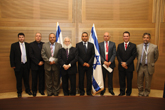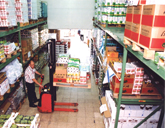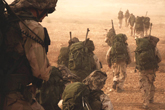×


We have detected your country as:
Please click here to go to the USA website or select another country from the dropdown list.

{image_1}The Rabbinical Council of Judea and Samaria released a statement in which they suggested that the Gaza flotilla incident was“the beginning of the Gog and Magog process[referring to Ezekiel 38]…
Continue Reading »
{image_1}In the aftermath of the Mavi Marmara Gaza flotilla incident, in which Israeli soldiers acting in self-defense resulted in the deaths of nine activists, Israel chose to significantly lighten the blockade of the Hamas-governed Gaza Strip….
Continue Reading »
{image_1}Occasionally, Bridges for Peace plans special evening events for the volunteer staff in Jerusalem. These opportunities give us a chance to enjoy dialogue with Jewish people and understand them better. Our last event not only included dialogue but music!
Continue Reading »
{image_1}Rachamim is a highly emotion-packed word, most often used to describe God. It is defined as “bowels, tender love, and pity” and is always in plural form, possibly to convey the intensity of the emotion behind it, though it’s not always translated as plural. In Hebrew, it is closely associated with rechem (Strong’s H7358), or “womb,” so when used in reference to God, rachamim (H7356) focuses on His parental love. Just as a womb protects the helpless unborn child, so He longs to create “a fence around the chaos,” as one online Bible teacher put it.
Continue Reading »
{image_1}Israel’s enemies are amassing against her and like a snowball rolling down a hill, they are gaining momentum as they go. International voices are vilifying Israel in the wake of the “flotilla affair” and accusations are rampant that she is an apartheid state, a Nazi regime, and a starver of Palestinian children. Statistics are being twisted and facts ignored in a frenzied attempt to delegitimize the nation. But in the midst of it all, growing numbers of parliamentarians worldwide are joining forces to support Israel within their governing bodies and to defend her in the international arena.
Continue Reading »
{image_1}In 1990, Israel was in the midst of a huge influx of new immigrants coming home to Israel—with 15,000 to 20,000 arriving each month! On September 11, the 100,000th immigrant to Israel was celebrated. Two years prior, God was already preparing Bridges for Peace to help meet this critical need.
Continue Reading »
{image_1}
“The flood of hate is being led by Israel's enemies all over the world…Dark forces from the Middle Ages are raging against us…Be prepared for difficult days.”—Israeli Prime Minister Benjamin Netanyahu
Continue Reading »
{image_1}
A new Israeli study reveals that too much sweetened soda and fruit juice may cause long-term liver damage. Switching to water is the best preventive measure to contribute to long-term health. According to [Christian Arab] Dr. Nimer Assy, director of the Liver Unit at Ziv Medical Center in Haifa,people who drink more than one liter (about four cups) of sweetened beverages a day have a five times greater risk of developing fatty liver. While known culprits like sweetened carbonated soda are on the list of “no-nos,” natural and freshly squeezed fruit juices appear there, too.
Continue Reading »
{image_1}When the thermostat rises on scorching hot days, the air conditioners kick in, causing a massive electricity surge that strains the grid. Summer blackouts and brownouts occur in the US every summer. If mismanaged, they may cripple cities and damage local economies. According to the US Department of Energy, residential heating and cooling account for more than 50% of the energy use in a standard American home.
Continue Reading »
{image_1}A successful Phase III clinical trial was completed by MediWound on its lead product, Debrase gel dressing for the treatment of second and third degree burns. ISRAEL21c reported that the trial included 175 patients at 25 medical centers around the world.
Continue Reading »All logos and trademarks in this site are property of their respective owner. All other materials are property of Bridges for Peace. Copyright © 2025.
Website Site Design by J-Town Internet Services Ltd. - Based in Jerusalem and Serving the World.